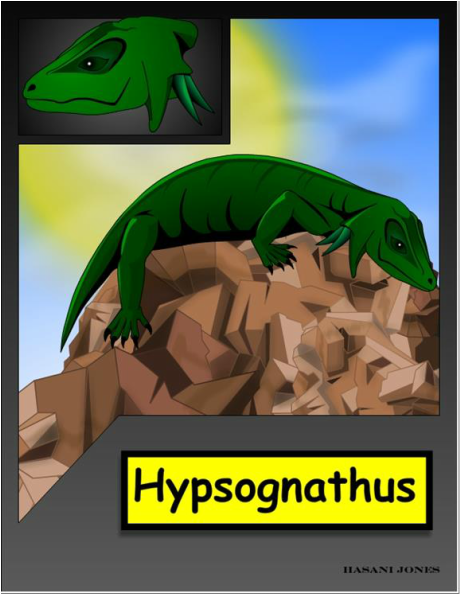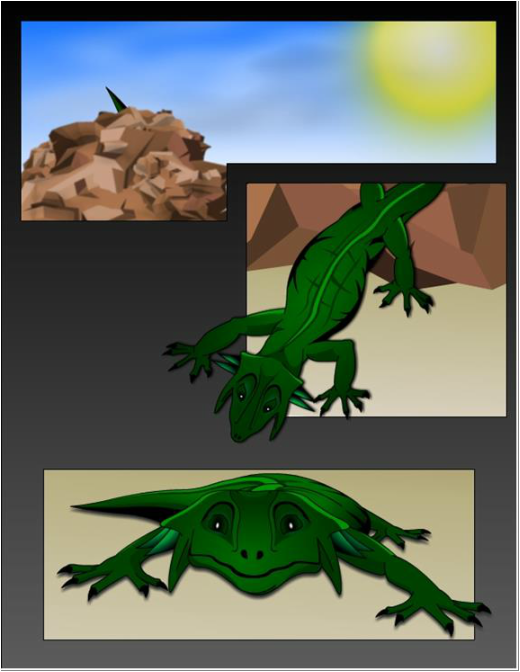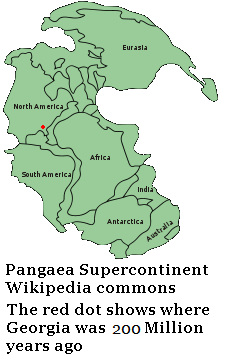
As we’ve seen, Coastal Plain sediments of South Georgia can be a thick blanket covering much older sediments which tell histories from very different times and climates.
Returning to the work of Dr. Tim Chowns; Professor of Geology for the University of West Georgia; the skull of a 200 million year old, Late Triassic reptile, genus Hypsognathus, was recovered from a drill core sample near the Savannah River in South Carolina at a depth of 2,016 feet.
Hypsognathus was a primitive reptile about 13 inches long and very much like a modern lizard, though they are unrelated; their bodies were low and broad with short tails, their heads were adorned with horns and their broad teeth suggest that they were herbivores. They are known to occur in the fossil records of both Connecticut and New Jersey.
Artist Hasani Jones created these superb images of Hypsoganthus as part of the Georgia Southwestern State University Commercial Art Project in support of this manuscript. The reptile is sunning on a rock after a cold night. Once the animal has warmed, the search for food will begin.
Returning to the work of Dr. Tim Chowns; Professor of Geology for the University of West Georgia; the skull of a 200 million year old, Late Triassic reptile, genus Hypsognathus, was recovered from a drill core sample near the Savannah River in South Carolina at a depth of 2,016 feet.
Hypsognathus was a primitive reptile about 13 inches long and very much like a modern lizard, though they are unrelated; their bodies were low and broad with short tails, their heads were adorned with horns and their broad teeth suggest that they were herbivores. They are known to occur in the fossil records of both Connecticut and New Jersey.
Artist Hasani Jones created these superb images of Hypsoganthus as part of the Georgia Southwestern State University Commercial Art Project in support of this manuscript. The reptile is sunning on a rock after a cold night. Once the animal has warmed, the search for food will begin.

Dr. Chowns reports that the area producing the fossil is a buried rift valley known as the Dunbarton Basin filled by red, sandy, conglomerate mudstones. Some researchers suspect that when Hypsognathus lived this might have been a desert valley of dry lake beds, but this remains a matter of ongoing debate.
This rift valley was in Central Pangaea, the supercontinent which had formed 300 million years ago and began to break apart again about 200 million years ago, right about the time our Hypsognathus lived.
The break-up of Pangaea is part of the Dunbarton Basin rift valley story.
Though deeply buried, this rift valley has been studied in multiple core samples taken by drilling rigs.
What’s interesting is that the Dunbarton Basin was formed when the terrific forces of continental drift (plate tectonics) tried, long ago, to slowly rip Georgia in half along her North/South axis. To rip Pangaea itself in half.
Today, in Africa’s rift valleys, you can see the same processes in action.
At different points in our state’s long history, some areas were crushed by continental drift while others were stretched like taffy.
The ancestors of Hypsoganthus survived the Permian/Triassic extinction event. The Triassic Period opens the Age of Reptiles; the Mesozoic Era; true dinosaurs emerged and rose to dominance.
Other reptiles are also well represented by the late Triassic turtles, true lizards, and true crocodilians had emerged. The highly diverse ichthyosaurs (fully marine reptiles) emerged during the Triassic as well as the marine plesiosaurs. By the end of the Triassic the early ancestors of mammals, the cynodonts, occur.
The Earth was fully capable of supporting intelligent life; there was ample terrestrial life; plant life was fully developed and capable of sustaining a diverse selection of herbivores; both vertebrate and invertebrate. The seas were well stocked with fish, shellfish, and marine reptiles.
Atmospheric oxygen levels were generally much lower than today’s while carbon dioxide levels were much higher; the poles were ice free. Pangaea was the supercontinent of the day, resting generally on the equator with the rest of the globe a single great ocean.
We would recognize little of our Earth; the animals were strange by our standards. Flowering plants, our staple food source, had only recently emerged and were very limited in their range. They bore little resemblance to the plants we know today.
It would be more than 196 million years before the first stone tool appear anywhere on Earth. The oldest known stone tools occur at about 3.4 million years ago; these weren’t made by our species; but cousin, ancestor species. Our species didn’t emerge until about 300,000 years ago; and by 50,000 years ago fully modern behavior is evident. Our species invented the earliest forms of writing about 8,000 years ago, that would set the stage for so much more.
Two hundred millions years ago the Earth was perfectly capable of supporting an intelligent species; but it would be a long, long time before stone tools or dugout canoes would be seen on the face of the Earth.
Reference:
The story of the Hypsognathus found in a drill core sample was first reported to me in a personal communication by Dr. Burt Carter, who referred me to Dr. Tim Chowns. Dr. Chowns confirmed the story and reported both stratigraphic & contemporary environment information.
The Dunbarton Basin/Africa correlation was also suggested by Dr. Burt Carter.
This rift valley was in Central Pangaea, the supercontinent which had formed 300 million years ago and began to break apart again about 200 million years ago, right about the time our Hypsognathus lived.
The break-up of Pangaea is part of the Dunbarton Basin rift valley story.
Though deeply buried, this rift valley has been studied in multiple core samples taken by drilling rigs.
What’s interesting is that the Dunbarton Basin was formed when the terrific forces of continental drift (plate tectonics) tried, long ago, to slowly rip Georgia in half along her North/South axis. To rip Pangaea itself in half.
Today, in Africa’s rift valleys, you can see the same processes in action.
At different points in our state’s long history, some areas were crushed by continental drift while others were stretched like taffy.
The ancestors of Hypsoganthus survived the Permian/Triassic extinction event. The Triassic Period opens the Age of Reptiles; the Mesozoic Era; true dinosaurs emerged and rose to dominance.
Other reptiles are also well represented by the late Triassic turtles, true lizards, and true crocodilians had emerged. The highly diverse ichthyosaurs (fully marine reptiles) emerged during the Triassic as well as the marine plesiosaurs. By the end of the Triassic the early ancestors of mammals, the cynodonts, occur.
The Earth was fully capable of supporting intelligent life; there was ample terrestrial life; plant life was fully developed and capable of sustaining a diverse selection of herbivores; both vertebrate and invertebrate. The seas were well stocked with fish, shellfish, and marine reptiles.
Atmospheric oxygen levels were generally much lower than today’s while carbon dioxide levels were much higher; the poles were ice free. Pangaea was the supercontinent of the day, resting generally on the equator with the rest of the globe a single great ocean.
We would recognize little of our Earth; the animals were strange by our standards. Flowering plants, our staple food source, had only recently emerged and were very limited in their range. They bore little resemblance to the plants we know today.
It would be more than 196 million years before the first stone tool appear anywhere on Earth. The oldest known stone tools occur at about 3.4 million years ago; these weren’t made by our species; but cousin, ancestor species. Our species didn’t emerge until about 300,000 years ago; and by 50,000 years ago fully modern behavior is evident. Our species invented the earliest forms of writing about 8,000 years ago, that would set the stage for so much more.
Two hundred millions years ago the Earth was perfectly capable of supporting an intelligent species; but it would be a long, long time before stone tools or dugout canoes would be seen on the face of the Earth.
Reference:
The story of the Hypsognathus found in a drill core sample was first reported to me in a personal communication by Dr. Burt Carter, who referred me to Dr. Tim Chowns. Dr. Chowns confirmed the story and reported both stratigraphic & contemporary environment information.
The Dunbarton Basin/Africa correlation was also suggested by Dr. Burt Carter.
